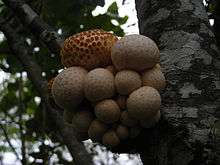Cyttaria espinosae
Cyttaria espinosae (Lloyd), also known by its local name Digüeñe, Lihueñe or Quideñe, is an orange-white coloured and edible ascomycete fungus native to south-central Chile. The Digüeñe is a strict and specific parasite of Nothofagus, mainly Nothofagus obliqua trees and cause canker-like galls on branches from which the fruiting bodies emerge between spring and early summer. The pitted surface generates air turbulence, preventing a build-up of static air around the fruitbodies, thus facilitating wind-borne spore dispersal. In Chilean cuisine, the Digüeñe is usually consumed fresh in salads or fried with scrambled eggs.
| Look up dihueñe in Wiktionary, the free dictionary. |
| Digüeñe | |
|---|---|
 | |
| Cyttaria espinosae from Chile growing in a tree branch | |
| Scientific classification | |
| Kingdom: | |
| Division: | |
| Class: | |
| Order: | |
| Family: | |
| Genus: | |
| Species: | C. espinosae |
| Binomial name | |
| Cyttaria espinosae | |
This article is issued from Wikipedia. The text is licensed under Creative Commons - Attribution - Sharealike. Additional terms may apply for the media files.